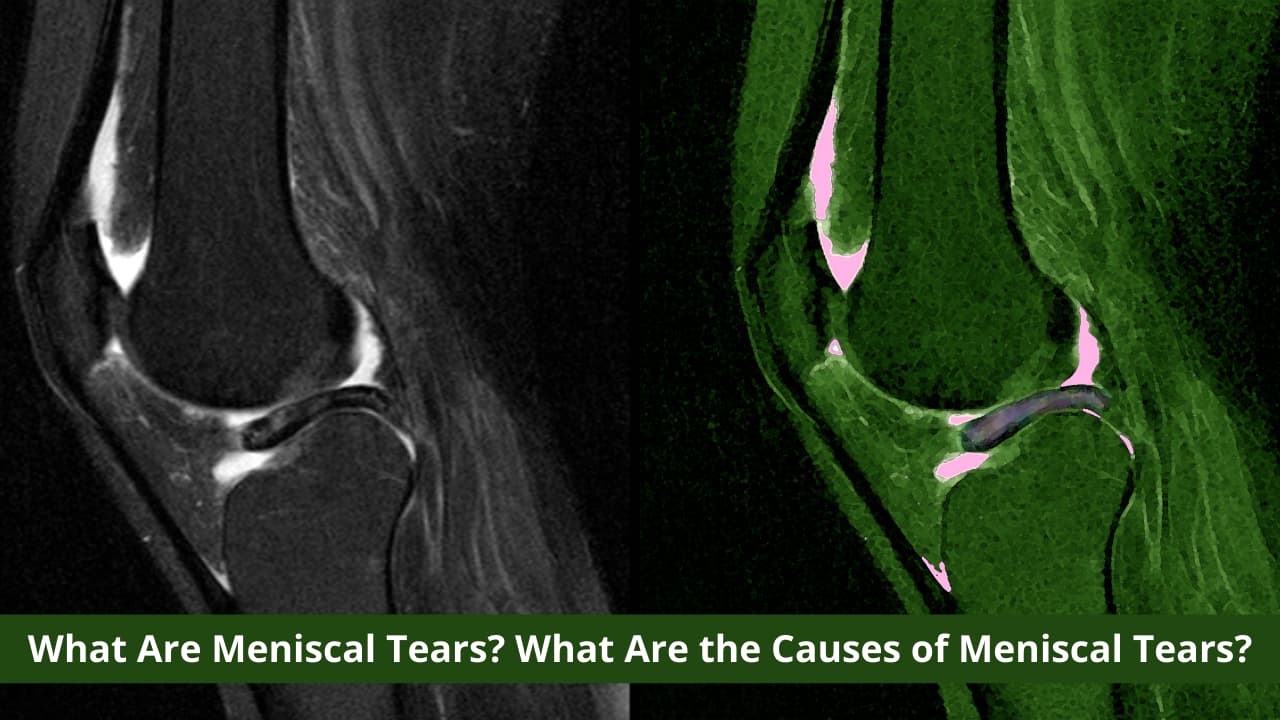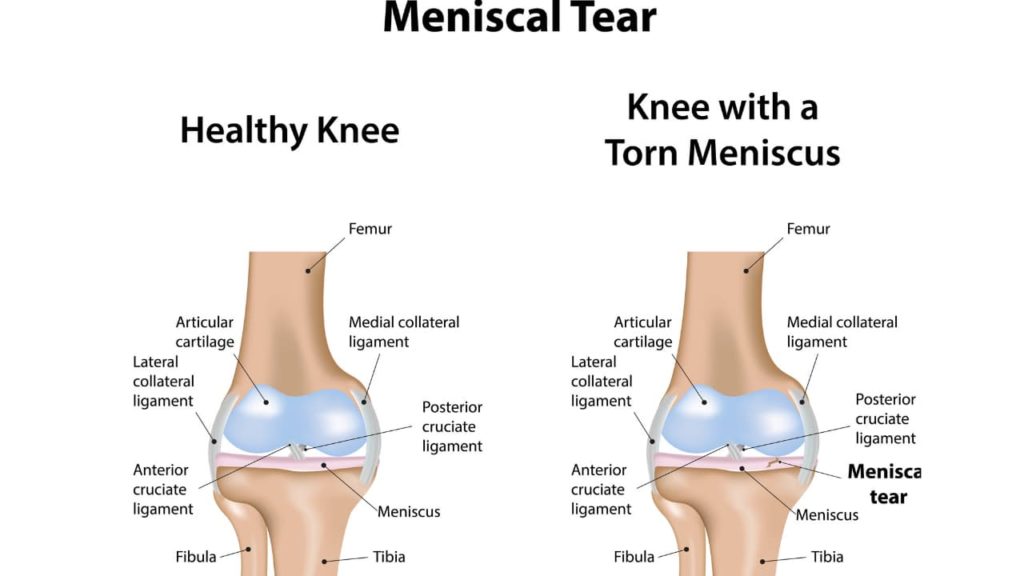What Are Meniscal Tears? What Are the Causes of Meniscal Tears?


What is a Meniscus Tear?
A meniscal tear, as the name suggests, is an injury to the menisci, thin cartilages (or semilunar cartilages) of the knee that sit between the femur (the only bone located in your thigh and longest bone of your body) and tibia (the shinbone).
More About Meniscal Tear And Meniscus
Your knees have two menisci that cushion your knee joint. When a meniscus is torn, it leads to inflammation and stiffness of the joints and causes pain.
A meniscal injury is one of the most common types of cartilage damages. And, like with other knee-related injuries, meniscal damage can be quite distressing and painful.
So, what is the function of the meniscus in your body? The meniscus cushions the knee and works as a shock absorber while providing stability to the joints. In addition, it also protects your bones from getting damaged due to regular wear and tear.
Besides, the semilunar cartilages also help in channeling nutrients into the cartilage and tissue that embrace the bones of your legs (femur and tibia). When these tissues are healthy, it becomes easy to check degenerative arthritis.
How Would You Understand That Your Menisci Are Torn?
Following are the signs and symptoms of a meniscal tear:
- Stiffness and swelling in the knee
- A sudden popping feeling in the knee
- Pain in the knee while rotating or twisting
- A locked feeling while moving your knee
- Problems with extending your knee
Initially, you might not feel intense pain and can even play or run with the injury. However, once your knee happens to swell, it is most likely to hurt a bit more.
When Should You Go to the Doctor?
If your knee swells or becomes painful or cannot move your knee properly, get in touch with your doctor at the earliest.
Call 1860-500-1066 to book an appointment
What Are the Causes of Meniscal Tears?
In most cases, all it takes is a sudden twisting or over-rotation of your knee to cause meniscal tears, such as a sports injury or any trauma.
People who are more than 30 years of age are more prone to such injuries. On the contrary, in younger people, the menisci are more flexible, strong, and rubbery. So, the incidences of meniscal tears are also fewer.
And, as we age, the menisci tend to become weak and prone to injuries. So, even a slight disbalance during a workout can tear the meniscus.
In some people, degenerative osteoarthritis can also lead to meniscal tears.
Sports-associated Meniscal Tears
Here are some of the common causes of sports-related meniscal tears:
- Any impact or trauma to the front or side of your knee joint, leading it to move/push to one side, can lead to a meniscal tear to either of the menisci. Such injuries also involve the ACL or anterior cruciate ligament in some cases. If you are an athlete, you might experience such trauma while playing football or basketball.
- If you happen to over-rotate your knee while moving your legs too aggressively, you might end up damaging your meniscus. Aggressive over-rotating is quite common in games like football, basketball, and soccer, among others.
- Sometimes disproportionate pressure on the knee joints can also cause meniscus damage. It can happen if you jog, squat, or step upon an uneven surface. Such accidents are commonly seen in football drills and cross-country trail running.
- Sudden, quick, and unexpected force on the knee can make the joint move too far and injure the meniscus while tearing it. This type of accident might happen on a basketball court where the knee of one player collides with another player and causes an impact.

Degenerative Ailment-related Meniscal Tears
Following are degenerative causes responsible for meniscal tears:
- With age, the meniscus cartilage tends to become weak and less flexible. It makes the incidence of injuries more common and easy, even if the impact is not too intense.
- If you have a degenerative joint ailment, such as osteoarthritis, or you are involved in activities that make your squat a lot, you are at a higher risk of getting a meniscal tear.
How Will Your Doctor Diagnose a Meniscal Tear?
Your doctor will ask you every detail about your injury and then examine you thoroughly. He/she is most likely to recommend taking an X-ray to understand if you also have fractured bones or not. For a detailed evaluation of your knee cartilage, your doctor may also suggest doing an MRI (Magnetic Resonance Imaging).
In some cases, the doctor may also want to take a look at the condition of your knee from the inside. In such scenarios, he or she may use an arthroscope (a device used for orthopedic tests) to do it by making a small cut on the skin near your knee.
What Are the Treatment Options for a Meniscal Tear?
In most cases, your doctor will start with the treatment, depending on the location, type, size, and severity of your injury. If your meniscal tear is due to arthritis, it is more likely to improve with the right treatment. So, initially, your doctor will not recommend surgery.
The standard treatment for meniscal tears mainly targets keeping the swelling and pain in check. The treatment is known as RICE (Rest, Ice, Compression, and Elevation). So, it begins like this:
- Rest. Your doctor is more likely to advise you to take rest for a couple of days and avoid doing any such activity that may worsen your pain, such as twisting or rotating your leg. In case your pain is too intense, your doctor may recommend using supportive devices like crutches. It will help you remove pressure from your knees and make you feel better.
- Ice. For a couple of days after the accident, your doctor is likely to ask you to use an ice bag on the affected area for 15 to 30 minutes every 4 to 6 hours. It will help you with alleviating the discomfort and pain.
- Compression. Your doctor will also suggest you wrap the affected area with a proper bandage and take medicines (non-steroidal anti-inflammatory drugs) along with it to keep swelling and pain under control.
- Elevation. Keeping your leg elevated can also provide you with relief and improve your condition over time.
So, it is all about the RICE therapy. Now let us take a look at the other treatment options.
Physiotherapy
Your doctor is more likely to prescribe physical therapy to you. It will help in strengthening your knee and leg muscles and properly stabilizing the joint.
Surgery
- Despite all the rehabilitative therapies, if your pain and other symptoms do not improve, your doctor may ask you to undergo surgery. Repairing a torn cartilage is possible in kids and young people.
- In case it is not possible to repair your meniscus, your doctor is likely to trim it surgically. This process is known as arthroscopic repair.
- If degenerative arthritis is the reason, your doctor will suggest getting knee replacement surgery. To young people, who have undergone surgery but still experience the symptoms of a meniscal tear (with no signs of advanced arthritis), the doctor may recommend a meniscus transplant.
Conclusion
A torn meniscus is very common. However, if you see your doctor on time, follow what he or she suggests, and make some lifestyle changes, you can get relief from the pain and discomfort owing to a meniscal tear.
Call 1860-500-1066 to book an appointment
© Copyright 2024. Apollo Hospitals Group. All Rights Reserved.
 +91 8069991061
Book Health Check-up
+91 8069991061
Book Health Check-up







